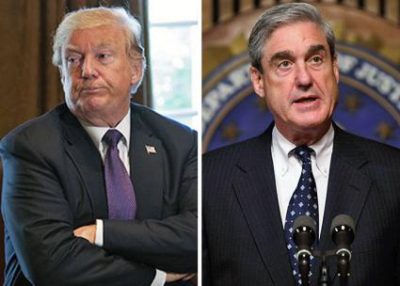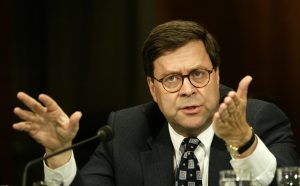Mueller Documented Probable Cause that Trump Obstructed Justice

After a nearly two-year investigation, culminating in a 448-page report, Special Counsel Robert Mueller concluded that Russia attempted to influence the 2016 election but found insufficient evidence to prove the Trump campaign conspired with Russia. Mueller did not decide, however, if Trump obstructed justice.
The special counsel detailed 10 acts that could constitute obstruction of justice. But based on a memo from the Department of Justice’s Office of Legal Counsel that says a sitting president can’t be indicted, Mueller refrained from concluding whether the evidence was sufficient to charge Trump with obstruction.
Mueller wrote:
If we had confidence after a thorough investigation of the facts that the President clearly did not commit obstruction of justice, we would so state. Based on the facts and the applicable legal standards, we are unable to reach that judgment. Accordingly, while this report does not conclude that the President committed a crime, it also does not exonerate him.
Yet, in spite of the fact that Mueller did not say the attorney general should decide whether Trump obstructed justice, William Barr took it upon himself to exonerate Trump of obstruction, less than 48 hours after he received Mueller’s report on March 23.
When the special counsel’s redacted report was made public on April 18, it became clear that Barr had whitewashed Mueller’s analysis. Indeed, Mueller systematically and methodically laid out the case for obstruction of justice against Trump.
Barr Mischaracterizes the Probable Cause Standard
The standard a grand jury uses to decide whether to issue an indictment is probable cause. Grand jurors must determine whether “a federal crime has probably been committed by the person accused,” according to the Handbook for Federal Grand Jurors. Once an indictment issues, a jury decides whether the defendant is guilty beyond a reasonable doubt, which is a higher standard than probable case.
During the April 10 Senate Appropriations Committee hearing, Sen. Jack Reed (D-Rhode Island) asked Barr whether Mueller found probable cause that Trump committed obstruction of justice. Although Mueller didn’t conclude whether a crime had been committed, he stated in his report that he could not exonerate the president. That, Reed told Barr, “suggests that there’s a possibility that probable cause existed for a crime.”
Reed noted,
“If there was no evidence of probable cause, then I would presume [Mueller] could’ve said very clearly that there was no crime committed, that he could in fact exonerate the president, as he seems to have done with the allegations of conspiracy between the campaign and Russia.”
After a long pause, Barr responded,
“Probable cause is a very low standard for determining when you start investigating something. A lot of things have probable cause.”
Barr’s characterization of the probable cause standard is incorrect. If a grand jury finds probable cause the defendant committed a crime, it will issue an indictment. Probable cause is not required to open an investigation.
Mueller Finds “Substantial Evidence” That Trump Obstructed Justice
In several places, Mueller found “substantial evidence” of obstruction of justice by Trump. For example, Mueller wrote:
Substantial evidence indicates that the President’s attempts to remove the Special Counsel were linked to the Special Counsel’s oversight of investigations that involved the President’s conduct — and, most immediately, to reports that the President was being investigated for potential obstruction of justice.
Substantial evidence is the standard of review appellate courts use to determine whether to uphold the findings of a lower court. If the appeals court finds substantial evidence to support the judgment, it will affirm the conviction.
Mueller cited the three elements necessary to prove obstruction of justice: 1) an obstructive act; 2) a nexus [connection] between the obstructive act and an official proceeding; and 3) a corrupt intent.
An obstructive act can be established even if there is insufficient proof of guilt of the underlying crime. It is not necessary that the defendant impede the proceeding directly, if it was foreseeable to the defendant that a third person would act on the defendant’s instruction to obstruct the proceeding. Acting with a corrupt intent means consciousness of wrongdoing, in order to obtain an improper advantage for himself or another person.
Here is one example where Mueller found substantial evidence of Trump’s obstructive intent:
Substantial evidence indicates that the President’s effort to have Sessions limit the scope of the Special Counsel’s investigation to future election interference was intended to prevent further investigative scrutiny of the President’s and his campaign’s conduct.
Mueller wrote that Trump’s intent can be judged by looking at all the evidence: “Judgments about the nature of the President’s motives during each phase would be informed by the totality of the evidence.”
The offense of obstruction of justice is complete when the defendant corruptly tries to obstruct justice. A prosecutor does not need to prove that justice was actually obstructed.
Mueller’s report is replete with examples of Trump ordering his underlings to obstruct the Russia investigation. He asked for former FBI Director James Comey’s loyalty. He asked Comey not to pursue an investigation of former National Security Adviser Michael Flynn. He asked Comey to say that Trump wasn’t the subject of an FBI investigation. He asked former White House Counsel Don McGahn to fire former Attorney General Jeff Sessions for recusing himself from the Russia investigation. And he asked Sessions to un-recuse himself and announce that the investigation would only pertain to meddling in future elections.
None of those people did what Trump asked. But the obstructive act is in the asking, whether or not those asked actually complied with Trump’s demands.
Trump also edited a statement for Donald Trump Jr., lying about the purpose of a June 2016 meeting between Russians and senior Trump campaign officials.
Mueller concluded,
“Taking into account that information and our analysis of applicable statutory and constitutional principles . . . we determined that there was a sufficient factual and legal basis to further investigate potential obstruction-of-justice issues involving the President.”
In 240 pages, Mueller’s report painstakingly analyzes the evidence of obstruction of justice by Trump.
“Our investigation found multiple acts by the President that were capable of exerting undue influence over law enforcement investigations, including the Russian-interference and obstruction investigations,” he wrote. “The incidents were often carried out through one-on-one meetings in which the President sought to use his official power outside of usual channels. These actions ranged from efforts to remove the Special Counsel and to reverse the effect of the Attorney General’s recusal; to the attempted use of official power to limit the scope of the investigation; to direct and indirect contacts with witnesses with the potential to influence their testimony.”
Although Mueller doesn’t make specific findings of probable cause that Trump obstructed justice, that’s because the Justice Department’s policy is that sitting presidents are unindictable.
“Viewing the acts collectively can help to illuminate their significance.” Mueller wrote.
If a prosecutor was inclined to bring criminal charges, there is abundant substantial evidence against Trump, which adds up to probable cause.
Mueller carefully analyzed Trump’s pattern of behavior and made a record for his post-presidency indictment. The special counsel also laid out a virtual road map for Congress to conduct impeachment proceedings. Obstruction of justice was one of the articles of impeachment charged against both former presidents Richard Nixon and Bill Clinton.
As Mueller wrote,
“The conclusion that Congress may apply the obstruction laws to the President’s corrupt exercise of the powers of office accords with our constitutional system of checks and balances and the principle that no person is above the law.”
*
Note to readers: please click the share buttons below. Forward this article to your email lists. Crosspost on your blog site, internet forums. etc.
Marjorie Cohn is professor emerita at Thomas Jefferson School of Law, former president of the National Lawyers Guild, deputy secretary general of the International Association of Democratic Lawyers and a member of the advisory board of Veterans for Peace. Her most recent book is Drones and Targeted Killing: Legal, Moral, and Geopolitical Issues.


